Can I make a confession? I am not a natural cable knitter. I enjoy knitting cables well enough, but I don’t love it. I do love knitting colourwork, openwork, and other kinds of knitted texture because the movement of yarn and needles feels completely natural to me. That’s not the case with cables, and it’s a kind of knitting in which I’ve always found it difficult to find my flow. I have wondered from time to time whether this is something to do with my stroke (since the dexterity of my left hand remains impaired) but I manage well enough with other knitterly techniques, and see no reason why my dexterity would only become a problem with a single, particular style of knitting. Whatever it is, I have never quite mastered the jiggery-pokery of cabling without a cable needle, and there’s just something about that brief pause of moving a stitch (or groups of stitches) behind, or in front of my work that disrupts my knitting rhythm. I’m sure if I exclusively devoted myself to cables and travelling stitches for a while that the mysterious flow would eventually find me, but it has, for a long time proved elusive.
But then I discovered Norah Gaughan’s Twisted Stitch Sourcebook.
As I said in my previous post, the twisting method used for the stitch patterns in this book is much more akin to the action of decreasing or increasing than it is to cabling. This method of creating texture is one I’d enjoyed previously (when swatching simple, repetitive motifs) but I’d certainly never considered the technique’s potential for creating fabrics of the gloriously varied and deeply appealing type that Norah explores so adroitly in her book.
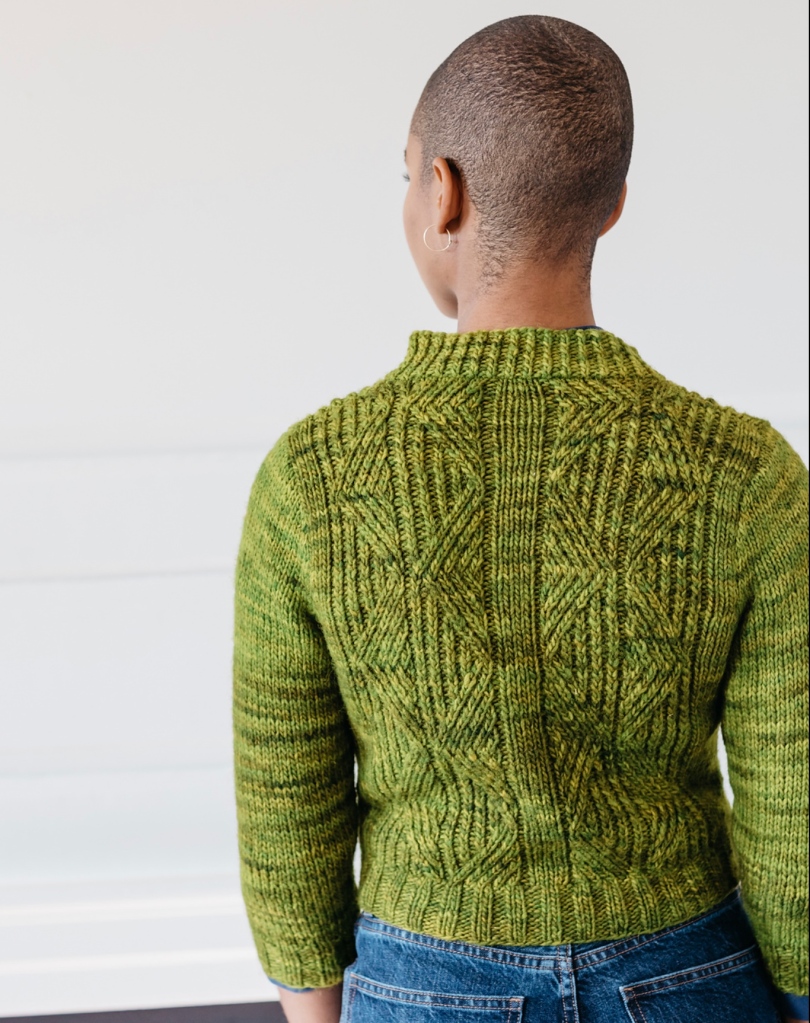
You could create this texture with a couple of simple manoevres and no cable needle? My eyes were opened and my mind was blown!
I immediately started swatching.
I swatched a number of the motifs from Norah’s book, and you’ll find my top favourites adapted or incorporated into the new group of patterns I’ve begun releasing.
But today I want to show you a different swatch.
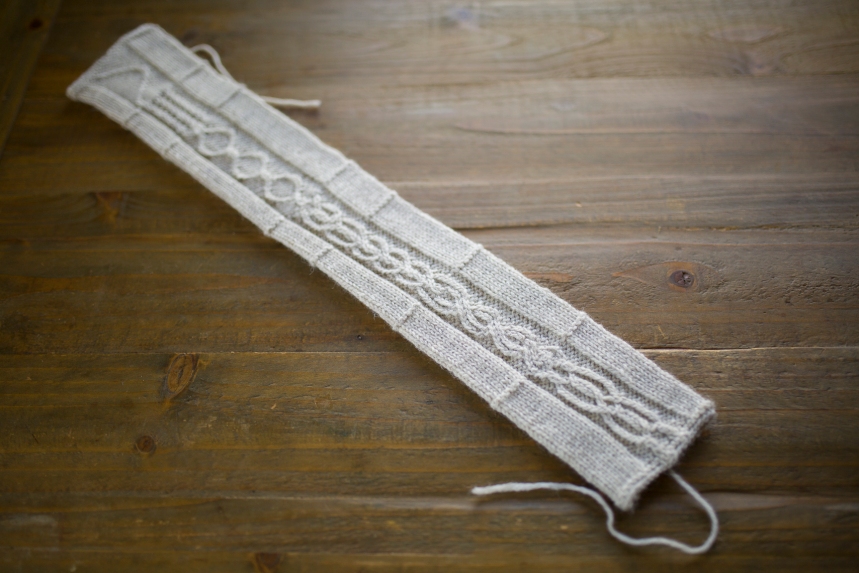
I’m showing you this particular swatch because it is the first one I made after I had my lightbulb moment sitting with the Sourcebook. And I’m also showing it to you because it’s an example of playing around, trying stuff out, exploring ideas, messing up – and moving on – and how swatching makes that happen.
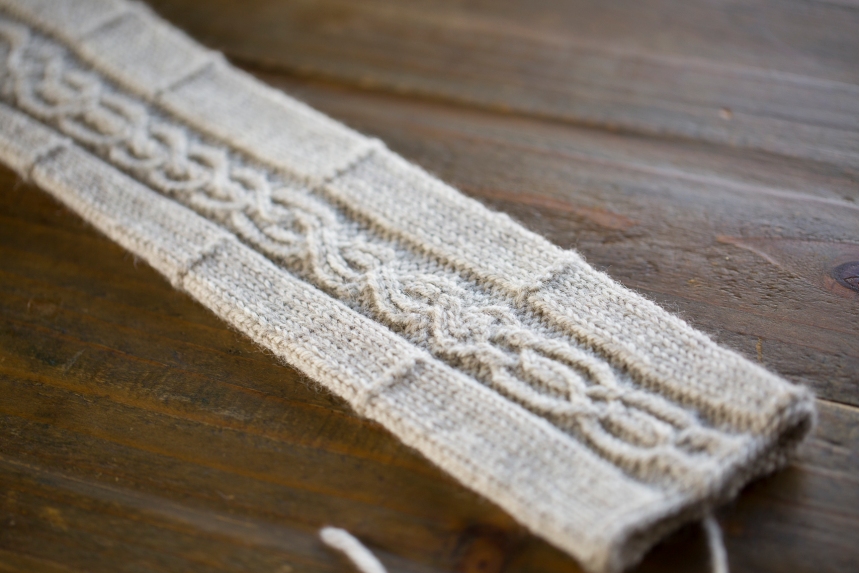
Because I design predominantly in the round, I like to make tubular swatches. These swatches generally have a central “pattern area” (in this case, it’s eight stitches wide) and I like to separate ideas / motifs with a round of garter stitch. Then I just go for it, with my eight stitches, and see what happens.
Here’s a section that didn’t work . . .

. . . followed by one that did.
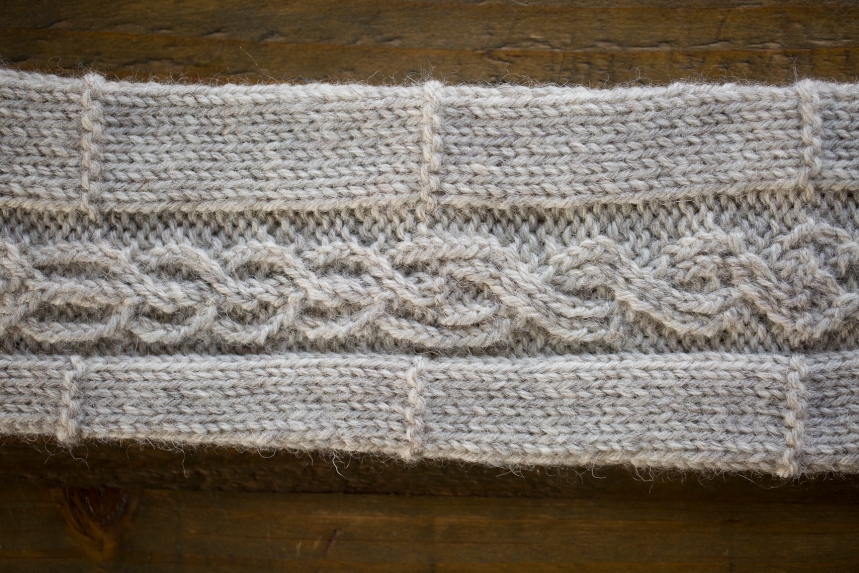
I enjoyed opening up the eight stitch pattern area into satisfying interlocking ‘O’s
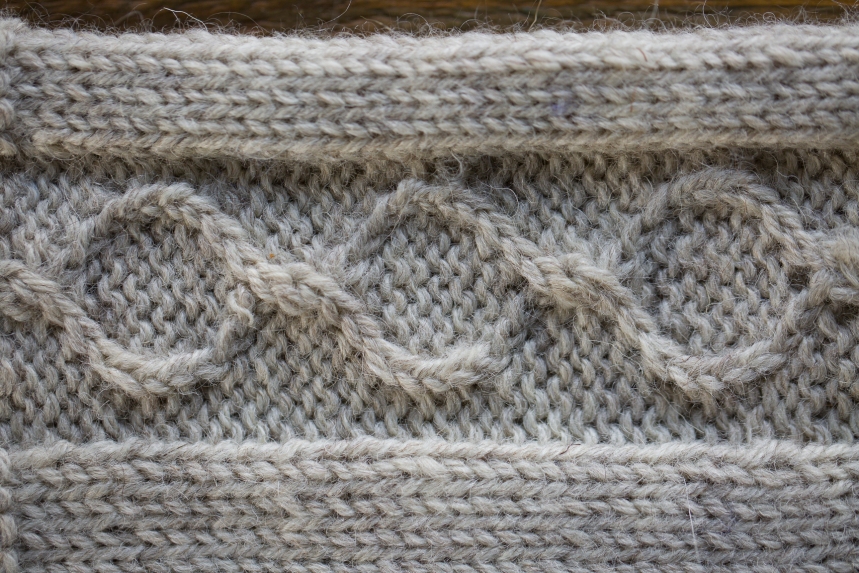
. . . and then compressing it right back down with this rather pleasing rib, which is formed by pairs of twisted stitches, crossed to the right on alternate rounds.
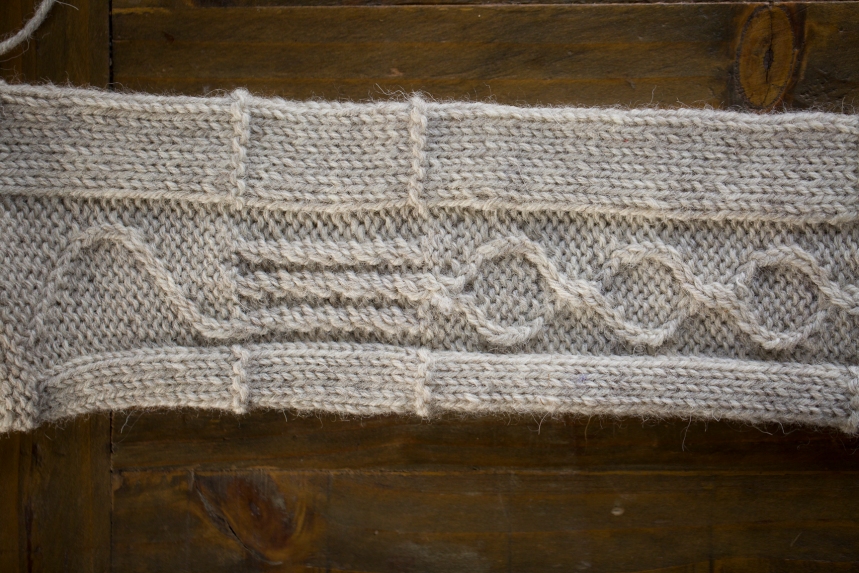
Involving ‘action’ on every round, the motifs on this swatch are of the undulating type that are found in many traditional Bavarian or Austrian patterns. Such motifs are more usually made with conventional cabling techniques, but here I’ve formed them with right or left twists, of the kind that Norah Gaughan describes in her Sourcebook.

Swatching is always an interrogation of stitch and fabric, and for me, this, wonky tube is important because it formed a creative bridge to somewhere else. For me, this was the swatch that finally allowed me to get into a natural rhythm with twisted stitches, and to think about their potential.
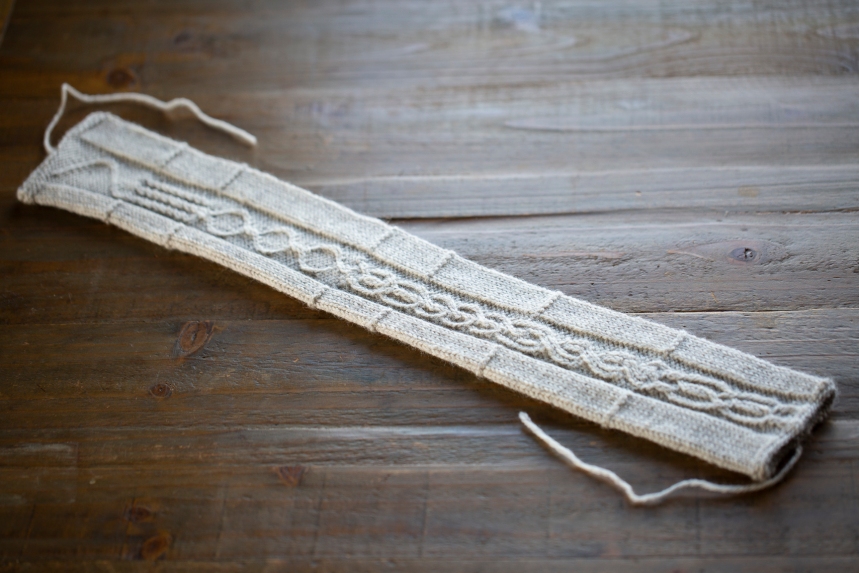
In this swatch I found my flow.


It appears this is the LAST email I’ve gotten from you. I’m horrified. I’m a long time subscriber, admirer and occasional purchaser.I re subscribed to the blog anyway on the website. But I wonder what I’ve missed. And I really want to get ALL communications from KDD or Kate Davies or whatever. Is there something else I should do?SusanSent from my Galaxy Tab® S2
LikeLike
What a lovely, lovely swatch! I often swatch in the same way – so satisfying, and yes, the flow! Trying out a pattern, getting ideas for how to alter it on the way, then trying out the alterations, generating ideas for further adjustments, and so on – and taking the TIME to work through it all!
I am curious about the use of the word “twisted” in this context in English.
In Danish, a “twisted stitch” is a stitch worked through the back loop, i.e. the stitch is twisted 180 degrees on itself. It may be a knit or a purl stitch.
When two stitches switch places, i.e. creating a mini cable of 1 stitch crossing (in most cases) 1 stitch, it is called “crossed stitches” – one stitch crosses over the other, distinguished from “cables” only by the amount of stitches moved. (But sometimes even these 1×1 crossed sts are called cables). Crossed stitches may be knit or purl, worked through the back loop or not. (In Danish, we don’t really have a term equivalent of “travelling stitches”.)
So in Danish, the Danish word for “twist” refers to the stitch itself. (It is similar in German, as far as I know, except there is also an – older? – German term for travelling stitches.)
How about the terminology in English/of Nora Gaughan? Does the “twist” refer to both the stitch itself or the “travelling” – or both?
(I will definitely put Nora’s book on my wishlist!)
Thank you for all the inspiration :)
Katrine
LikeLike
There’s a bit more an explanation in this post, Katrine – https://kddandco.com/2021/10/31/twisted-stitch-disambiguation/
– but yes, it’s both . . . it’s interesting to hear about the Danish and German twisting terminology. So many knitting terms are culturally specific, and then, as they work their way into general use, shift and change their meanings (steek is a good example – a Scots word that originally referred to stitching closed – and now means to cut stitches open! )
LikeLike
Thank you, I actually just discovered and read your previous post on that subject – very enlightening!
Now I will have to swatch Nora’s method systematically (which I even “invented” for an old design of my own to avoid the fiddle of crossing…). With that method, the “stitch on top” doesn’t twist on itself, as far as I can remember?
One more question, though: As I read you, when twisting and crossing stitches, you first work the stitches through the back loop, then cross them. That puzzles me, as I would always cross the stitches first, then work them in their new order -?
I too own several German/Austrian pattern collections – endless inspiration to be found :)
Cheers
Katrine
LikeLike
the process is slightly different for the left and right twists – I find thinking about the process as one of decreasing and increasing simultaneously useful – more useful than regarding it as twisting or crossing (if that makes sense at all). So in short I’d say: swatch and see! You can also work the left twist without slipping the sts knitwise (though it doesn’t then match the right quite so well)
LikeLike
Thank you for your response.
And I stand corrected: In my own old design, I did in fact NOT do as Nora G does, but made a regular M1 increase picking up the horizontal bar (left or right twist, depending), followed or preceded by a regular k2tog or ssk decrease.
What lovely fiddliness to be brooding over as knitters :)
LikeLiked by 1 person
fascinating!
LikeLike
How many stitches do you usually cast on for the in-the-round swatch? Just curious.
LikeLike
Depends on the yarn / gauge – but generally around the same the no of sts I’d cast on for a sleeve (to fit on a wee circ)
LikeLiked by 1 person
Thanks.
LikeLike
Woman! I love your mind and the way you play. You always make me happy. I’m glad I have you and your brood and your art and your curiosity in my life over here across the pond. Peace, sister.
LikeLiked by 1 person
Thanks to you I have just received Norah Gaughan’s book arrived TODAY! So give me time to start dipping and planning. Personally I just love knitting I remember doing a lot of cables 50 years ago and still take them on. Love the texture but I also love lace, beads with lace and colour work.
LikeLike
Kate, I love the idea of swatching your way into flow! So often it is the pressure of making a proper sleeve or hat or wearable-something that makes me less willing to take risks and less happy with my struggles.
The idea of tubular swatches was brand new to me until yesterday, when I discovered this glorious example from a museum in Fair Isle. I love that your post came less than 24 hours later–feels like the cosmos winking at me! Anyway, I suspect you might have seen these grand tubular swatches? (Go to 23:32) https://www.youtube.com/watch?v=5uMMM4LhkFI
LikeLiked by 1 person
ooh!
LikeLike
Interesting, I have been knitting cables my whole knitting life (60 years) and never gave them a thought! Now I will try ‘your’ twisted stitches and see how that goes. funny how they look more complicated ……..thanks.
LikeLike
I like the idea of tubular swatching…eliminating those annoying little pieces you have to uncurl. Yours is so delightful. I love texture in fabrics. Perhaps your cable-anxiety is now water under the bridge? Thanks for the encouragement and insights!
LikeLike
Kate, I’m glad it’s not just me that feels that way about cables. I love the effect created but always try to avoid them if I can for exactly the reasons you mention. I will definitely explore twisted stitches as an alternative to the dreaded cable needle. Best wishes.
LikeLike
I understand completely..´I also do not like doing cables and avoid them at all costs. Breaks the rhythm
LikeLike
A lovely piece. Thank you for sharing. I‘m looking forward to trying it as well.
LikeLike
Thank you for sharing. I get so disheartened when some thing I have tried has not worked but everything is is about exploring, making mistakes and learning and trying again.
LikeLiked by 1 person
absolutely!
LikeLike
I love reading about your creative process and this swatch is lovely. I think this has convinced me to buy Norah Gaughan’s book, or at least make up a pattern of hers I have had an eye on for a while. These twisted stitches have so much potential. I look forward to seeing what you will do with them in the future.
The only thing that doesn’t appeal to me personally from a visual standpoint (and I know this differs from others) is a twisted rib.
I am not sure why, but I prefer the soft squish of a traditional rib, as the twisted rib seems too rigid somehow. The softer rib offers an appealing contrast to a sharper motifs. That sharper geometry probably is why Norah’s designs work so well in making a statement overall. What attracts us and why is so interesting: symmetric, asymmetric, curving, angular, etc. And actually, looking at Norah’s lovely design above it seems she has used a standard 2×2 rib for the bottom and cuffs and a twisted motif for the collar only.
LikeLiked by 1 person
I’m now doing my 2nd Easwas hat. It took a lot of chanting my version of the RT and LT to get the muscle memory to work. Then the trickle of understanding happens. So I bought the Sourcebook. I was a little unnerved to discover much of her work is flat knitting, so I now have to use the same process for wrong side twists!I
Thank you for sharing your swatching.
LikeLike